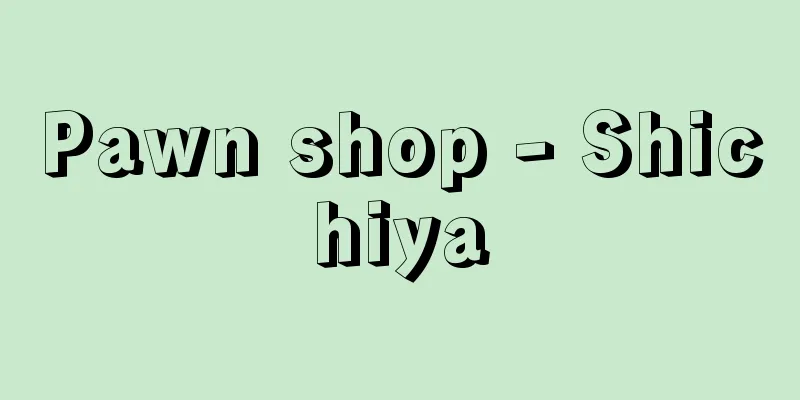Pawn shop - Shichiya

|
A business that lends money using goods (movables) as collateral. Businesses that only lend goods as pawns and lend money in return for their deposit began to appear in the mid-Kamakura period, and were initially called "kura" (storehouses), which further developed during the Muromachi period and were commonly known as "doso" (also known as "dogura") or "dozo." Many of the newly emerging sake shops also operated as money lenders, so they were also called "sakaya dozo." This was because they needed to build large, sturdy warehouses to store the pawned goods. As a product of the development of urban life in Kyoto, Kyoto, their hoarding of wealth and extravagance drew resentment from the common people, and they sometimes even became the target of "doikki" (peasant uprisings). In the early modern period, the name "shichiya" became more common. With the nationwide development of castle towns, including Kyoto, Osaka, and Edo, pawnbrokers came to play an important role as a means of financing the living expenses of the urban lower classes. Pawnbroker associations were formed early on in castle towns around the country, and various regulations were imposed. The position of pawnbrokers in the financing of the common people in the early modern period can be imagined from the figures of 2,731 Edo pawnbroker associations in 1723 (Kyoho 8), 628 Kyoto pawnbrokers in 1699 (Genroku 12), and 2,420 Osaka pawnbrokers at the end of the Edo period. Pawnbrokers' collateral was everyday items such as clothing, accessories, and furniture, and they were used mainly to finance the living expenses of the poor urban people, and although the amounts handled were small, they were used as a convenient and convenient financial method. Moreover, the "foreclosure" period was relatively short, the interest rate was relatively high, and the lender was in charge of storing and disposing of the pawned items, so there were many favorable conditions for pawnbrokers in all respects. It is no surprise that pawnbrokers, along with mortgage-free loan sharks, played a major role in financing the general public in the early modern period. Pawnbrokers continued to operate for a long time after the Meiji period, playing an important role as an easy way for the urban lower classes to obtain loans. [Toshimi Takeuchi] Pawnbrokers have been widely used by ordinary people since ancient times, as they lend out small amounts of money quickly and easily for short-term living expenses, mainly using their own funds. However, interest rates are relatively high due to the need to prepare storage facilities for the pawned items, the hassle of storing miscellaneous pawned items, and the tiny loan amount per unit. Furthermore, if a certain period of time passes without repayment of the principal or interest, the pawned items are disposed of, known as "foreclosure," and the proceeds are used to repay the principal and interest. In Japan, pawnbrokers, along with second-hand dealers, were considered bases for investigations into stolen and lost goods, and were subject to strict controls. After the Meiji Restoration, control regulations were initially enacted for each prefecture, and control was based on these regulations. In 1884 (Meiji 17), the Pawnbroker Control Ordinance was enacted as a unified national law that only applied to pawnbrokers, and control was strengthened. The harsh control imposed by this ordinance led to a succession of arrests of pawnbrokers, which further spurred the closure of pawnbrokers, which had been increasing due to poor business caused by the recession. As a result, there was an active movement to revise the ordinance, and in 1895, the Pawnbroker Control Law was enacted, which revised the ordinance's strict prohibition on accepting pawned goods and police inspections, and relaxed the penal provisions. This law served as the basis for control until the Pawnbroker Business Law was enacted after World War II. Furthermore, in 1927 (Showa 2), the Public Pawnbrokers Law was enacted from a social policy standpoint, allowing local governments and social welfare corporations to establish public pawnshops, and public and private pawnshops to coexist. After the Second World War, in 1950 (Showa 25), the Pawnbroker Control Law was abolished and the current Pawnbroker Business Law was enacted. In order to operate a private pawnbroker, a license must be obtained from the prefectural public safety commission in the area where the business office is located under this law. The redemption period is set at more than three months from the date of pawn contract establishment, and interest is subject to the "Law Concerning the Control of Acceptance of Contributions, Deposits and Interest Rates, etc.", but in the case of pawnbrokers, the maximum limit is set at 0.3% per day and is calculated on a monthly basis. The number of private pawnshops peaked at 21,539 in 1958, and the number of public pawnshops at 1,142 in 1939, and has been on a downward trend ever since. In 1983, the number of private pawnshops was 8,715, while the number of public pawnshops was 61, and by 2007 (Heisei 19), the number of private pawnshops had fallen to 3,579. The public pawnshop system was abolished in 2000. This decline in the number of pawnshops is due to the rise in national income and the improvement of the social security system, as well as the spread of credit cards and loans from financial institutions and the development of easy personal finance such as salaryman loans, which led to a decline in the use of pawnshops. For this reason, in recent years, there have been an increasing number of pawnshops that buy and sell items, and sell items online on the Internet. [Nori Ishino] "Japanese Pawn Shops" by Ryuichi Shibuya et al. (1982, Waseda University Press) [Reference] |Source: Shogakukan Encyclopedia Nipponica About Encyclopedia Nipponica Information | Legend |
|
もっぱら物品(動産)の「質物(しちもつ)」を担保として金銭貸付を行う業者。質物を物品に限り、その預託を「見返り」に金銭貸付をする業者の出現は鎌倉中期からで、当初「庫倉(くら)」とよばれ、室町期にはさらに発展して「土倉(どそう)」(どぐらとも)、「土蔵」と通称された。そして新興の酒屋にも貸金業を兼ねるものが多かったので、酒屋土倉と併称もされた。質物保管のため壮大堅固な倉庫の設営が必要であったからである。京洛(きょうらく)都市生活の発展の所産で、彼らの蓄財豪奢(ごうしゃ)ぶりは庶民の反感をも買い、ときには「土一揆(どいっき)」の抗争目標にさえなった。近世に入ると「質屋」の名称が一般化した。京坂・江戸をはじめ城下町の全国的発展に伴い、質屋はおもに都市下層民の生活資金調達融資の方途として重い役割を担うことになる。各地の城下には質屋仲間の結成が早くから行われ、種々の規制が加えられもした。1723年(享保8)の江戸質屋仲間2731、1699年(元禄12)の京都質屋628、幕末の大坂質屋2420という数字からも、近世庶民金融に占める質屋の地位は想像できよう。質屋の担保は衣類、装身具、家具など身近の生活用具で、もっぱら都市細民の生活資金調達にあてられ、扱う金額も少額ではあったが、それだけにまた簡便臨機の金融手段として活用された。しかも「流質」期限は比較的短く、そのうえ金利も割高で、質物の保管処分も貸し主の手にあるため、万般に質屋にとって有利な条件が多かった。「抵当なし」の「高利貸」と並んで、質屋が近世庶民金融の主役として働いたのも当然である。明治以後もなお質屋営業は久しく続き、都市下層民の手軽な融資方途として重要な役割を担ってきた。 [竹内利美] 質屋は主として自己資金を用いて、少額で短期の生計資金などを簡易迅速に貸し付けるので、古くから広く庶民によって利用されてきた。しかし、質物の保管設備を整える必要があること、雑多な質物の保管に手数がかかること、1口当りの貸付金額が零細であることなどから、その利息は割高となっている。また、元利金の返済なく一定期間を経過すると、質物は「質流れ」と称して処分され、元利金の弁済に充当されることになっている。 日本においては、質屋は古物商とともに盗品や遺失品捜査の拠点とみなされ、厳しい取締りの対象とされてきた。明治維新後、当初は府県別の取締規則が制定され、それに基づいて取締りが行われていたが、1884年(明治17)に質屋のみに適用される全国統一立法として質屋取締条例が制定され、取締りの強化が図られた。この条例による過酷な取締りによって検挙される質屋業者が相次ぎ、不況による営業不振から増加しつつあった質屋の廃業にいっそうの拍車をかけることになった。そのため同条例の改正運動が活発化し、1895年には同条例の厳しい質受けの禁止や警官の立入検査などの条項を修正し、罰則規定を緩和した質屋取締法が制定された。同法は、第二次世界大戦後に質屋営業法が制定されるまで、取締りの基礎とされた。また、1927年(昭和2)には、社会政策的な見地から公益質屋法が制定され、地方公共団体や社会福祉法人によって公益質屋が設立されて、公・私営の質屋が共存することとなった。 第二次世界大戦後の1950年(昭和25)に質屋取締法は廃止され、現行の質屋営業法が制定された。私営質屋を営業するには、同法に基づいて営業所の所在地の都道府県公安委員会の許可を受けなければならない。流質期限は質契約成立の日から3か月以上とされ、利息については「出資の受入れ、預り金及び金利等の取締りに関する法律」が適用されるが、質屋の場合は最高限度は1日当り0.3%とされており、月単位で計算されることになっている。 私営質屋は1958年の2万1539を、公益質屋は1939年の1142を頂点として、その後減少傾向を続け、1983年には私営質屋8715、公益質屋61となり、2007年(平成19)には私営質屋は3579まで減っている。また公益質屋の制度は2000年に廃止された。この質屋数の減少は、国民所得の向上、社会保障制度の充実とともに、金融機関のカード・ローンの普及やサラリーマン金融など手軽な個人向け金融の発達によって、質屋利用が低下したことによる。このため、最近では買取販売やインターネットのオンライン販売を行う質屋が多くみられるようになった。 [石野 典] 『渋谷隆一他著『日本の質屋』(1982・早稲田大学出版部)』 [参照項目] |出典 小学館 日本大百科全書(ニッポニカ)日本大百科全書(ニッポニカ)について 情報 | 凡例 |
<<: Stew - shichu (English spelling) stew
Recommend
Luge - luge (English spelling)
Athletes ride a sled lying on their backs and sli...
Intaiga - Intaiga
Paintings created by artists of the Painting Acad...
air hoar
...Ice formed when the temperature near the groun...
stencil duplicator
… A hand-operated printing press is usually calle...
Roman Haubenstock‐Ramati
1919‐1994 Polish composer. From 1947 he worked in ...
Henry Mayers Hyndman
British socialist. Founder of the Social Democrat...
Magma
According to Pliny, the name magma was used for th...
Kitashigeyasu [town] - Kitashigeyasu
A former town in Miyaki County, eastern Saga Prefe...
Wasp fan beetle
...The growth process also undergoes hypermetamor...
Houshi [Hot Spring] - Houshi
A hot spring in Minakami Town, Gunma Prefecture. B...
Xin shǐ (English: History of the Heart)
Written by Zheng Sixiao (1241-1318) in China at th...
Republic of Gilan (Soviet) Republic of Gīlān
A local revolutionary government in Iran. It was p...
Plasma - Plasma (English spelling)
The word plasma is a Greek word meaning "a s...
Somali - Somali (English spelling)
A Cushitic ethnic group found widely in Somalia, n...
Niutsuhime Shrine
Located in Kamiamano, Katsuragi-cho, Ito-gun, Wak...









